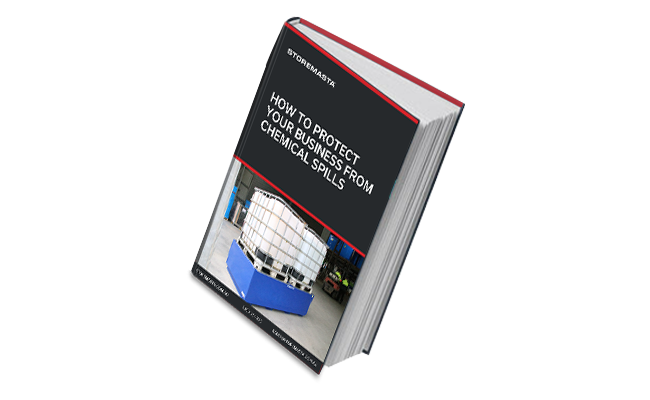Safe chemical storage in laboratories is a fundamental part of ensuring compliance and chemical safety. But choosing the right engineering controls, such as a chemical cabinet, is only the first step. In this blog, we’ll be taking a deep dive into the further measures that you can take to ensure that your chemical cabinets and stores remain organised, compliant and free of risk. Read on to learn more about our 10 top tips for the safer storage of chemicals in the lab.
1. Accurate Labelling
The very nature of lab work means that chemicals will often be transferred or dispensed as part of daily work procedures. However, keeping an up-to-date label on all chemical containers is also a key step in risk reduction.
Packages should always be labelled in accordance with relevant regulations, so that staff are aware of the chemical properties – as well as the hazards.
If you’re transferring chemicals from one container to another, make sure that the new container is clearly labelled with accurate information.
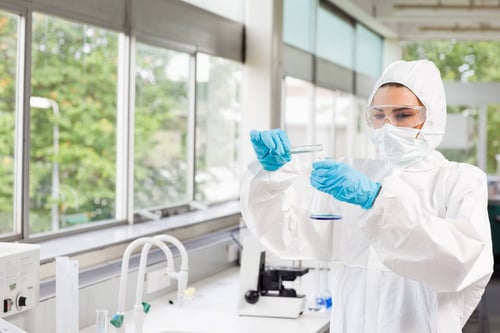
If chemicals are being transferred or dispensed, make sure that the new container is properly labelled.
2. Knowledge Of Materials
To properly handle and store chemicals in a laboratory setting, knowledge of the onsite materials is key. To bolster the effectiveness of your engineering controls, you must also ensure that your personnel have a solid understanding of your individual chemical products.
The Safety Data Sheets of each onsite chemical must be available to all staff, to assist with the identification and minimising of hazards. Furthermore, adequate training and supervision should be implemented to make sure that all staff fully understand the information that’s listed on the Safety Data Sheets.
This includes the relevant information about:
- Chemical class of the substance
- The effects on human health
- Physical hazards of the substance
- Incompatibilities with other substances
- Personal protective equipment requirements
- Guidelines for safe handling and storage
- Emergency procedures
- First aid
3. Controlling Chemical Stocks
When you’re working with chemicals, it’s important that the quantities of substances that you have onsite is kept to a minimum level. While that may seem like an unusual tip for a laboratory, the streamlining of chemical ordering can assist with the reduction of excess hazardous substances that will be stockpiled onsite.
By assessing and reviewing your chemical ordering procedures, you can help reduce the risks posed by hazardous substances through limiting the volume that’s kept in your lab.
DID YOU KNOW: In a laboratory setting, the maximum capacity for indoor chemical storage cabinets is 250L? Cabinets are a key control measure that assists with protection from impact damage, the segregation between incompatible substances and spillage containment. They also provide a 10 minute window of time to allow for the evacuation of the premises and the use of firefighting equipment, in the event of a fire.
4. Check Usage and Shelf Life
In addition to our previous point, it’s a good idea to develop a regular inspection checklist that involves reviewing the chemicals that you have in stock and checking the shelf life of each container.
Chemicals that are out of date can be ineffective, unsafe or unstable, so ensure that rotations are performed so that older stock is moved to the front of your chemical cabinets. This will assist your lab staff in using the older stock before opening a new chemical bottle.
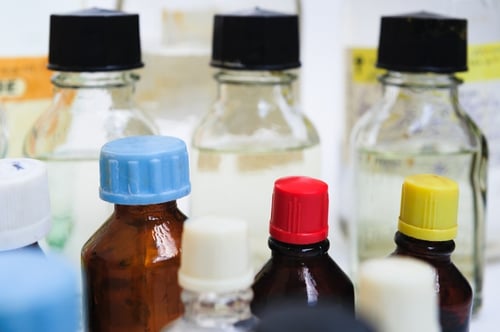
Developing a regular inspection checklist for your chemical cabinets is a good way to ensure stock is within its used by date.
5. Decontamination Of Old Containers
Even empty chemical containers can still cause safety issues, such as corrosion, toxic poisoning and ignition. If you’re placing empty chemical containers in the waste disposal area, make sure that they’re properly decontaminated and taken away by a company who is authorised to conduct such chemical waste disposal work.
Containers that have held hazardous chemicals must be treated the same way as if they were full, as residue and vapours can still create chemical hazards. Any chemical packages or receptacles must be rendered free from hazardous chemicals through the process of decontamination. Refer to the Safety Data Sheet of your particular chemical product to determine the safest way to decontaminate your empty containers.
6. Opening Packages
Whether you’re opening a chemical package, dispensing substances, sampling chemicals or transferring the contents of a container to another, you must carry out these tasks in a safe and compliant manner.
This means only opening packages and transferring hazardous chemicals in an area that is free from hazards. Never use the top of a chemical cabinet or the interior of a cupboard as a space to dispense or transfer chemicals.
When chemical packages are open, vapours and spillage may occur, so having chemically compatible materials, proper segregation and adequate ventilation is necessary for maintaining chemical safety at work.
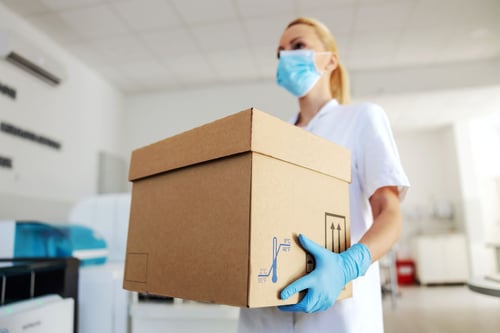
Never open or transfer hazardous chemicals on top of, or within, equipment that is not designed for that specific purpose.
7. Handle Leaks Immediately
Leaks and spills may be regular occurrences in a laboratory setting. However, regardless of how little chemical is spilled, it must be tended to immediately.
Creating a spill response procedure for your laboratory is the best practice method of managing leaks and spills. An integral part of your spill response is ensuring that your staff members receive the proper spill clean-up training, so that they can quickly and effectively use the spill kits to contain and control the spillage.
Keep a spill kit close to every area of your lab that poses a spill risk, so that trained and authorised staff can quickly isolate the area, assess the spill, and start the clean-up process.
Like to know more about spill prevention?
8. Hazard Identification
While the labelling of your chemical containers and the availability of SDS is a crucial part of laboratory chemical safety, it’s also important to ensure that all personnel are aware of the hazards in each room of the lab.
To assist with this hazard identification, you must clearly display dangerous goods and hazard signage at the entrance to rooms where hazardous substances are held. Information may include dangerous goods class labels, the packaging groups of chemicals, as well as emergency contact details.
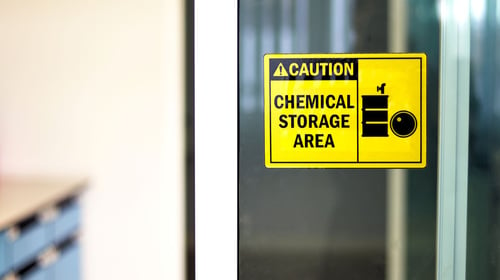
Alerting all personnel to the hazards inside a particular room of your laboratory is part of your safety and compliance obligations.
9. Check Chemical Packages Upon Delivery
You may have installed the best chemical cabinets and trained your staff to be experts in chemical safety, but don’t forget to create procedures for the delivery and transfer of your chemical packages.
During the delivery process, chemical packages can travel through various sets of hands and be subject to a range of different environments and conditions. When the packages arrive at your laboratory, make sure that the staff accepting the delivery first inspect the packages for signs of leaks or damage.
If packages have been incorrectly stacked, handled or transported, the container may show signs of damage including cracks and dents. This could in turn lead to leaks and spills of hazardous chemicals, as well as the release of harmful vapours and gases.
Create a procedure for the receiving and dispatching of materials, which includes a thorough inspection of chemical packages before they’re accepted by your staff.
REMEMBER: If you have taken possession of the packages and noted leaks or damage once the wrapping is removed, move the chemical containers to a safe area for repacking or disposal. Make sure that chemical labels are reattached or replaced, so that staff are aware of the type of chemical product, as well as its hazards.
10. Clean and Organise Cabinets
Unfortunately, you can’t always escape housework when you travel into a laboratory to carry out your daily duties. Just like at home, laboratories must be maintained to ensure safety and hygiene.
Chemical storage areas can become cluttered, disorganised and unsafe if housekeeping tasks are not completed on a regular basis.
Some key signs that your cabinet requires attention include:
- Chemical bottles and containers are in disarray
- There is an unexpected odour coming from your cabinet
- You can see dirt, grime or spillage within the cabinet
- There are old, damaged or unlabeled containers in the cabinet
- The spill sump has not been checked recently
- Shelves aren’t adjusted to suit the height of the containers
- The exterior of your cabinet is unclean
- There are various items, such as paperwork, old containers or rubbish, left on top of (or within) your cabinet
- Doors can’t close properly as the chemical containers are stacked incorrectly

Maintaining a clean and organized environment for your chemical containers is an important part of chemical risk reduction.
Chemical Storage In Laboratories
Ensuring chemical safety in the lab is an ongoing process that requires knowledge, diligence and re-assessments of the working environment. To ensure the safe storage of hazardous substances, we highly recommend you develop an inspection and review process that allows you to better monitor and maintain your chemical storage and handling areas.
To learn more about chemical safety, you can access our free eBook. Our easy-to-read guide will introduce you to our 4-step risk control methodology, which can be applied to any workplace, including your lab. Grab your copy today by clicking on the image below.
Joining the team as a Dangerous Goods Storage Consultant, Melissa Hampton became Storemasta's Marketing Manager in late 2021. With extensive knowledge and experience in chemical compliance, Melissa is responsible for leading the Marketing team and helping shape their marketing strategy. In her spare time, you can find Melissa hiking, swimming and enjoying the great outdoors in beautiful north-west Tasmania.
